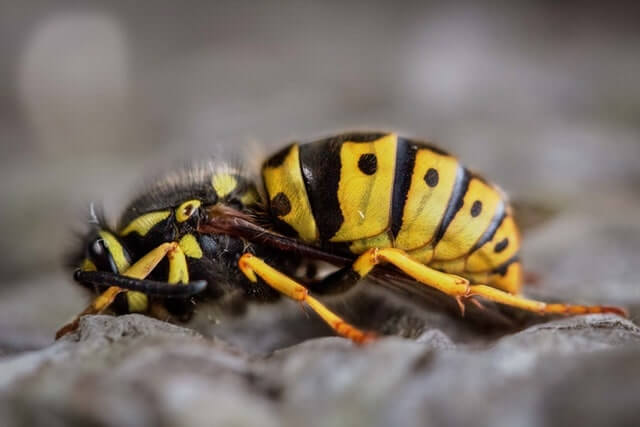Every spring, summer, and fall, millions of people suffer from the presence of aggressive stinging insects in their yard. Learn more about wasps, different types of nests, and how we treat in different scenarios. Wasp control is made easy with Done Right Pest Solutions.
For the best pest control wasp removal services, give us a call for a free wasp removal cost estimate: 651-342-9489.
Table of Contents
- Wasps
- As Spring Pests: Paper Wasps
- How We Treat Wasp Nests
- How We Treat Paper Wasps
- Conclusion & Next Steps
Wasps
Wasps are yellow and black stinging insects ranging in size of a half of an inch to 1 inch long, though they can get up to 2 inches long. They have a pinch in their abdomen, and their ends come to a point where their stinger rests. Wasps have 6 legs, 2 antennae, a head, thorax, and mouth parts that can even eat other insects.
Wasps can either be social insects or solitary insects. It is important to know the distinction prior to planning any wasp control.
Solitary insects, like mud daubers, typically have 1 insect per colony, a female who lays eggs, constructs the nest, etc. Once the eggs hatch, the queen brings food to the nest or lures other insects to kill and feed to the larvae.
The larvae then turn into grown stinging insects and flies off to begin their own solitary journey.
Social insects are found in groups where 1 queen begins the search for a safe place to build a nest, begins building, and lays eggs. The hatched and grown worker wasps then forage for food for the colony and build the nest bigger for developing insects.
Did you know there is a type of parasitoidal wasp that lays its eggs on another insect or host for food. Unlike other parasitoidal insects that do this, the larvae kills the insect host.
Yellow jackets and hornets are often confused as wasps, but reside in a close relative family. These pests are considered very aggressive in the spectrum of stinging insects. Hornets and yellow jackets are often smaller in size than a wasp.
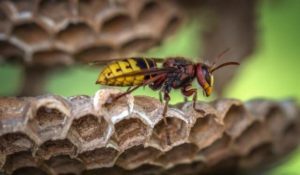
Stings
Every year, 50 to 100 people die in the United States alone from stinging insects.
Only bees lose their stinger (and ultimately life) when they sting, so bees typically don’t sting unless they absolutely need to. This is another reason why bees should be protected.
Wasps, hornets, and yellow jackets do not lose their stingers and can sting many times without consequence to them. This is why it is important to have the best pest control wasp removal services out there, offered by Done Right Pest Solutions.
Some people are immune to stinging insect venom, while others are dangerously allergic. With the rise in the cost of EpiPens and other medical supplies, it is important to keep yourself and your family safe from these stinging insects.
It is important to have effective stinging insect control over aggressive wasps, hornets, and yellow jackets. Give us a call for a free wasp removal cost estimate: 651-342-9489.
Pro tip: Never close the opening of a stinging insect colony thinking they will die off in there. These insects will become aggressive. We’ve experienced that stinging insects will find their way out of a trapped space, whether that is to the outside or the inside of a home.
Nests
Nests can look different depending on the stinging insect.
Paper Wasps actually secrete a chemical and place it around the base of their nests to repel ants and other insects from invading their homes.
Paper Wasp nests are usually either umbrella-shaped, spherical-shaped, or oddly-shaped.
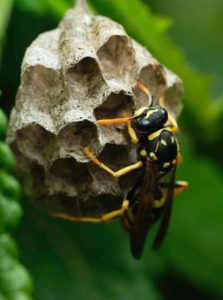
Other types of nests that wasps can make are dirt nests and mud nests. These nests are often camouflaged against siding or soffit material.
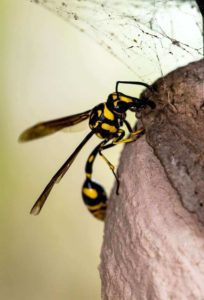
Wasps usually make their nests in trees and overhangs of homes and businesses before they would make their home in a foundation or in the ground. Still, wasps do occasionally resort to those areas, so it is important to be on the lookout.
Hornets and yellow jackets are much more likely to build their nests in the foundation or ground. These stinging insects are also aggressive, and so it’s important to be careful when mowing and keep your distance if you find a nest.
If you come across a ground nest or hidden nest, it is important to call a pest professional to handle this situation. You never know how big the colony is inside the hidden space.
Pro tip: Never close the opening of a stinging insect colony thinking they will die off in there. These insects will become aggressive. We’ve experienced that stinging insects will find their way out of a trapped space, whether that is to the outside or the inside of a home.
As Spring Pests: Paper Wasps
Paper Wasps make their nests out of what is called true paper. It is that paper-like substance with open holes.
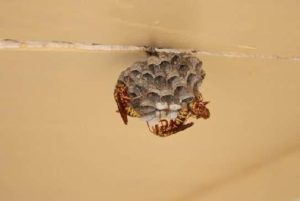
Paper wasps are not very aggressive, and they only sting when threatened or when their nests are threatened.
They often hang their nests under tree limbs, under porches and overhangs, under your soffit and facia area of the roofing, etc.
Paper Wasps and migratory wasps often will make their home in the soffit and facia area of a home to overwinter. They come out in the spring as queens to search for a new place to build a nest.
Preventative pest control in the spring is vital to keeping these pests out of your home all year!
How We Treat Wasp Nests
Our technicians use a liquid product or a dust product to treat visible nests. They will stand back at a safe distance to spray the nest with a potent product that cuts through these stinging insects’ bodies so they cannot sting the technicians.
It is best to treat these stinging insects at their least active time of day (early morning or later at night).
The product always has to be both a direct kill agent and a residual chemical that lingers for any stinging insects that are out and about foraging for the queen.
The technician will give the product a few moments to have the full affect and then will remove the nest if possible. Once the nest is removed, the technician will treat the area where the nest was attached (branch, siding, door post, soffit, overhang, etc.).
Treating these areas ensures that any surviving members of the colony who are about foraging will come back to where the nest was, land on the area, climb around looking for the nest. The product will attach itself to the insects’ legs and bodies and begin to attack their nervous system.
Then within a couple of minutes to hours these stinging insects will die so they don’t get the chance to sting someone.
Pro tip: Never close the opening of a stinging insect colony thinking they will die off in there. These insects will become aggressive. We’ve experienced that stinging insects will find their way out of a trapped space, whether that is to the outside or the inside of a home.
How We Treat Paper Wasps
For any stinging insects that has the affinity to search for housing in the soffit, facia area leading to the wall voids of a home, we treat the exterior of the home in the spring so that these insects don’t make a home in your home.
Prevention is key for stinging insects, that’s why we treat preventatively in the spring and fall along the soffits, facia, and gutter areas. These preventative treatments are included in our Peak Seasons Plan, which covers you year-round for any crawling, jumping, flying, and stinging insects, as well as mice, rats, and voles.
The product is similar to the previously described product, with capabilities of both a direct-kill agent and a residual chemical. It is applied with a power sprayer and dries clear within an hour.
Preventative wasp control is long term control, but we are highly experienced in both preventative wasp control and reactive wasp control. Learn more about our hornet and wasp control services, or give us a call for our wasp removal cost estimate! 651-342-9489.
For other tips and tricks regarding stinging insects, check out this category of our blog.
Conclusion & Next Steps
Wasps can be resilient insects. You learned different types of wasp nests and what to look out for around your home. You also learned the importance of wasp control, stinging insect control in general, and how we treat individual nests and spring wasp control.
If you ever have these stinging insects or other types like hornets or yellow jackets, just let us know. We would love to take care of these pests for you!
Call today for a free estimate! 651-342-9489.
Done Right Team
Have you had a wasp horror story? These things are nothing to mess with! We would love to hear your story below and if you got rid of them on your own.
Want to learn more about different pests? Or maybe about services and promotions we offer? Sign up for our free newsletter!

